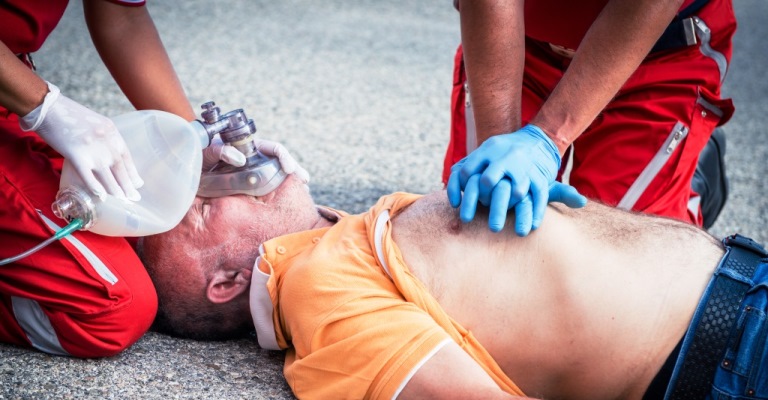
6 ຄວາມຜິດພາດການປະຖົມພະຍາບານສຸກເສີນທົ່ວໄປ
ເຫດການສຸກເສີນມັກຈະປະທ້ວງໂດຍບໍ່ມີການເຕືອນ. ມັນສາມາດເປັນເລື່ອງງ່າຍເກີນໄປທີ່ຈະເຮັດຄວາມຜິດພາດໃນການຊ່ວຍເຫຼືອຄັ້ງທໍາອິດໃນສະຖານະການເຫຼົ່ານີ້ເຖິງວ່າຈະມີຄວາມຕັ້ງໃຈທີ່ດີທີ່ຈະໃຫ້ການຊ່ວຍເຫຼືອ
From what not to do in nosebleed accidents to old wives’ tales that make a burn worse, here are ການຊ່ວຍເຫຼືອຄັ້ງທໍາອິດ mistakes a responder should avoid in case of an emergency.
ການຝຶກອົບຮົມການຊ່ວຍເຫຼືອຄັ້ງທໍາອິດ? ຢ້ຽມຢາມຮ້ານທີ່ປຶກສາດ້ານການແພດ DMC DINAS ຢູ່ທີ່ງານວາງສະແດງສຸກເສີນ
First Aid Myths and Mistakes
Everyone may want to step in and help in an emergency. But sometimes, lack of training in first aid response can harm or endanger a casualty’s life.
Many remember some essential first aid elements and rules.
The question is whether that knowledge is still correct or somewhat fragment memories that have lost their usefulness.
Several widespread and dangerous mistakes happen in the desire to help others.
Some may cause discomfort and interrupt the healing process unless it receives proper treatment.
Knowing and understanding some of the most common dangerous first aid mistakes one should never put into practice is vital.
ວິທະຍຸຂອງການຊ່ວຍເຫຼືອຂອງໂລກ? ຢ້ຽມຢາມຮ້ານວິທະຍຸ EMS ຢູ່ງານວາງສະແດງສຸກເສີນ
Here are six common first aid mistakes one should avoid
-
Putting ice on a burn
Applying ice on the burn site only causes frostbite and other skin damage.
Putting on butter and toothpaste are also wide-known myths that can only worsen an injury.
Treatment for burns should start with proper cleaning and cooling process.
Run the burned area under cool water for about five to ten minutes.
Alternatively, use a clean, cool, and wet cloth to the injury site.
Apply topical antibiotic cream to prevent infection and take OTC medications (such as acetaminophen or ibuprofen) to ease pain and swelling.
Remove any clothing that covers the burn but does not peel it away if it adheres to the skin.
Doing so will only cause more damage to the underlying skin.
-
Leaning back during a nosebleed
It is a common first aid mistake to lean back during a nosebleed, which will only make the blood run down a person’s throat and swallow it.
Swallowing blood can lead to stomach irritation and ອາການປວດຮາກ.
Leaning back during a nosebleed does nothing to control the bleeding.
Instead, lean forward and pinch the tip of the person’s nose.
Leave it for ten minutes and observe if it stops on its own.
If this does not help, immediately rush to a doctor to determine the condition.
-
Moving an injured, unconscious casualty
Do not move an injured casualty involved in a road collision or vehicular accident.
Doing so will only make the situation worse.
Disregard this rule only in extreme conditions, such as a vehicle catching fire or ongoing traffic within the area.
If the situation is not extreme, call an ambulance and try to turn off the vehicle’s engine.
Try to stop any bleeding and help the victim remain stable until emergency services can take over the scene.
-
Putting heat on sprain or fracture
It is a fact that heat can soothe aches and pain, but it is no help in treating sprain or fracture.
Doing so can only increase the swelling and pain.
Use the RICE treatment for sprains and fractures.
Apply a cold compress to the injury site for 20 minutes on and off.
When possible, raise the sprained or fracture area to help with the blood circulation and reduce swelling.
-
Applying a tourniquet to any bleeding
In a bleeding emergency, it is a mistake to squeeze a tourniquet over the wound immediately.
This mistake can cause permanent nerve and muscle damage and lifelong lesions in the tissues and blood vessels.
The use of this technique does not stop arterial bleeding.
Instead of using a tourniquet, apply pressure directly on the wound to stop the bleeding and prevent damage.
Bandage the area with fresh gauze and elevate.
-
Giving CPR after a heart attack
A heart attack occurs when part of the heart muscle does not receive enough blood.
In most cases, the person is still conscious and breathing, which means they do not need CPR.
The person does not need CPR unless the heart attack develops into cardiac arrest, in which the person is rendered unconscious and not breathing.
In a cardiac arrest, push hard and fast in the centre of the person’s chest until an ambulance arrives.
Hands-only CPR proves to be more effective than a conventional resuscitation with rescue breathes in the first few minutes of the attack.
Learning First Aid Can Make a Big Difference
It is all too easy to forget your first aid knowledge in a state of panic.
These common first aid mistakes only make things worse for an injured casualty.
There is no question that formal first aid training can make a big difference in these situations.
It prompts people to be more alert in the surroundings they are well in and promotes an overall sense of safety.
Learn first aid today and avoid making these six critical first aid mistakes.
ອ່ານຍັງ:
ມີຊີວິດສຸກເສີນຫຼາຍຂຶ້ນ…ສົດ: ດາວໂຫລດແອັບຟຣີໃໝ່ຂອງໜັງສືພິມຂອງເຈົ້າສຳລັບ IOS ແລະ Android
ສິ່ງທີ່ຄວນຢູ່ໃນຊຸດປະຖົມພະຍາບານເດັກ
ອາການຊ໊ອກໄຟຟ້າປະຖົມພະຍາບານແລະການປິ່ນປົວ
ການປິ່ນປົວ RICE ສໍາລັບການບາດເຈັບຂອງເນື້ອເຍື່ອອ່ອນ
ວິທີການປະຕິບັດການສໍາຫຼວດເບື້ອງຕົ້ນໂດຍໃຊ້ DRABC ໃນການປະຖົມພະຍາບານ
Heimlich Maneuver: ຊອກຫາວ່າມັນແມ່ນຫຍັງແລະເຮັດແນວໃດມັນ
10 ຂັ້ນຕອນການປະຖົມພະຍາບານຂັ້ນພື້ນຖານ: ການໃຫ້ບາງຄົນຜ່ານວິກິດການທາງການແພດ
ການປິ່ນປົວບາດແຜ: 3 ຄວາມຜິດພາດທົ່ວໄປທີ່ເຮັດໃຫ້ເກີດຄວາມເສຍຫາຍຫຼາຍກ່ວາທີ່ດີ
ຄວາມຜິດພາດທົ່ວໄປສ່ວນໃຫຍ່ຂອງຜູ້ຕອບ ທຳ ອິດກ່ຽວກັບຄົນເຈັບທີ່ຖືກກະທົບໂດຍອາການຊckອກ?
ຜູ້ຕອບ ຄຳ ຖາມສຸກເສີນກ່ຽວກັບເຫດການອາຊະຍາ ກຳ - 6 ຄວາມຜິດພາດທົ່ວໄປທີ່ສຸດ
ການລະບາຍລົມດ້ວຍມື, 5 ສິ່ງທີ່ຄວນເອົາໃຈໃສ່
10 ບາດກ້າວໃນການປະຕິບັດການແກ້ໄຂກະດູກສັນຫຼັງທີ່ຖືກຕ້ອງຂອງຄົນເຈັບທີ່ເປັນໂຣກເຈັບ
ຊີວິດຄົນເຈັບ, ຄວາມຜິດພາດທີ່ສາມາດເກີດຂື້ນໃນວິທີການຂອງຜູ້ຕອບແບບ ທຳ ອິດກັບຍາດພີ່ນ້ອງຂອງຄົນເຈັບ?



